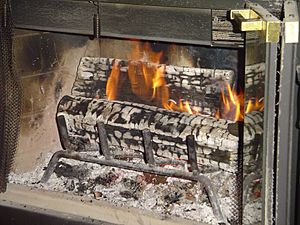Chemical change facts for kids
A chemical change happens when materials turn into completely new substances. These new substances have different features and properties than the original ones. Think about burning wood: once it's burned, it becomes ash and smoke. You can't turn that ash back into wood! This is a chemical change because new things like carbon dioxide are formed.
Other examples of chemical changes include burning a candle, rusting of iron, or baking a cake. The special features that describe how a chemical change happens are called chemical properties.
Contents
Chemical Change vs. Physical Change
It's important to know the difference between a chemical change and a physical change. A physical change is when a substance changes its look or form, but it's still the same substance. No new substances are made.
For example, if you break a stick of wood, it's still wood, just in smaller pieces. Other physical changes include changing a substance's shape, like bending metal, or changing its state, like ice melting into water. When water freezes or boils, it's still water. These changes are often easy to reverse.
Types of Chemical Changes
Scientists who study chemistry, called chemists, group chemical changes into three main types. These are inorganic, organic, and biochemical changes.
Inorganic Chemical Changes
Inorganic chemistry looks at reactions involving elements and compounds that usually do not contain carbon. These changes often happen in labs or in large factories.
- Neutralization: This is when an acid mixes with a base. They react to form water and a salt.
- Oxidation: This includes reactions like combustion (burning) or rusting. When iron rusts, it reacts with oxygen in the air.
Organic Chemical Changes
Organic chemistry focuses on the chemistry of carbon and the substances it reacts with. Carbon is a very special element because it can form many different kinds of compounds. These compounds are found in things like mineral oil, medicines, paints, detergents, cosmetics, and fuels.
- Cracking: An example is "cracking" heavy hydrocarbons at an oil refinery. This process breaks down large oil molecules into smaller ones, like gasoline, which is more useful.
- Polymerization: This is when small molecules join together to form very long chains, creating polymers. Plastics are made this way.
Biochemical Changes
Biochemistry studies the chemical changes that happen inside living things. These changes help organisms grow, move, and stay alive. Many of these reactions are controlled by special proteins called enzymes and are influenced by hormones.
- Photosynthesis: This is how plants make their own food. They use carbon dioxide and water to create sugars and oxygen with the help of sunlight.
- Digestion: This is the process where your body breaks down food to get energy and nutrients.
- Decomposition: When plants and animals die, tiny living things like fungi and bacteria break down their bodies. This is also a biochemical change.
Signs of a Chemical Change
You can often tell if a chemical change has happened by looking for certain signs. However, these signs don't always mean a chemical change has occurred, but they are good clues!
- Change of smell: The substance might start to smell different.
- Change of color: For example, when iron rusts, it changes from shiny silver to reddish-brown.
- Change in temperature or energy: The reaction might give off heat (called exothermic) or absorb heat (called endothermic), making things hotter or colder.
- Light and/or heat given off: Like when something burns, it produces light and heat.
- Formation of gases: You might see bubbles forming in a liquid.
- Formation of a precipitate: This is when solid particles form in a liquid and settle at the bottom.
- Decomposition: Food rotting is an example of organic material breaking down.
- The change is hard or impossible to reverse: Like you can't turn ash back into wood.
See also
 In Spanish: Reacción química para niños
In Spanish: Reacción química para niños


